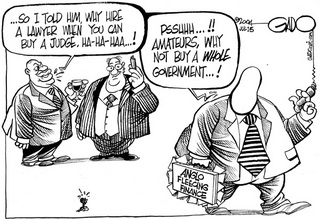Corruption in Infrastructure
By Paul

“A very promising research area is the use of randomized field experiments. A recent paper by Olken (2005) reports the results of such an experiment in Indonesia which measures missing expenditures in over 600 village projects. To do so, the author relied on a comparison of the villages’ official expenditure reports with estimates of the prices and quality of all inputs used in road construction and maintenance, each made by independent engineers. This approach allows a separation of the sample into sub-samples designed to test the effectiveness of various types of policies in reducing corruption.
What do these studies show? Most of the evidence confirms the expectations. First, the basic data analysis from the Global Competitiveness report suggests that the frequency with which firms have had to make undocumented extra payments or bribes to get connected to public utilities or to gain public contracts is, on average, negatively correlated with the income of the countries. These responses suggest that the poorer a country is, the bigger the corruption problem in infrastructure. While useful these data are also far from being precise. They are based on executive surveys which are known to have their share of problems. More importantly, it tells us little about what the government or the residential infrastructure users think about corruption. Second, corruption can be tracked to greater constraints on utility capacity and lower competition among utilities. This is found by Clarke and Xu (2004) for 21 Eastern European countries. They also find that public ownership in that region is more correlated with corruption than private ownership of utilities. Third, corruption can be associated with higher than expected costs. The most detailed studies ( Flyvbjerg and various colleagues) show that excess costs can be attributed to procurement rules that give bidders an incentive to announce low costs to increase their chances of winning projects, then renegotiate….
What can we do to reduce corruption in infrastructure? There are basically four main directions in which theoretical researchers have been pushing for over 20 years: (i) privatization, (ii) regulation and related processes, (iii) increased decentralization, and, (iv) adoption of participatory process in the selection, implementation, and supervision of projects. Since many countries have tried these recommendations, we now have enough new facts to analyze. This analysis is still very young but already yielding interesting results.”
Infrastructure: A survey of recent and upcoming issues
The paper comes from the Annual Bank Conference on Development Economics - ABCDE Tokyo 2006.
Here’s a podcast overview and a video of the opening session.
A related conference in South Africa- see especially the paper 2010 World Cup- Infrastructure Challenges.
PSD Blog has more on corruption.